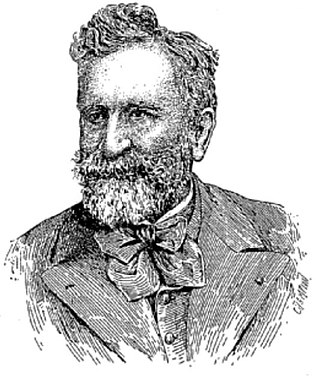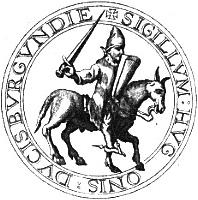
Marie Henri d'Arbois de Jubainville was a French historian, philologist and Celtic scholar.

Hugh III was Duke of Burgundy between 1162 and 1192. As duke, Burgundy was invaded by King Philip II and Hugh was forced to sue for peace. Hugh then joined the Third Crusade, distinguishing himself at Arsuf and Acre. He died at Acre in 1192.
Eudes, French for Odo, may refer to:

Hugh was the Count of Champagne from 1093 until his death.

The House of Burgundy was a cadet branch of the Capetian dynasty, descending from Robert I, Duke of Burgundy, a younger son of King Robert II of France. The House ruled the Duchy of Burgundy from 1032 to 1361 and achieved the recognized title of King of Portugal.
Odo is a name typically associated with historical figures from the Middle Ages and before. Odo is etymologically related to the names Otho and Otto, and to the French name Odon and modern version Eudes, and to the Italian names Ottone and Udo; all come from the Germanic word ot meaning "possessor of wealth".

Odo II was the count of Blois, Chartres, Châteaudun, Champagne, Beauvais and Tours from 1004 and count of Troyes and Meaux from 1022. He twice tried to make himself a king: first in Italy after 1024 and then in Burgundy after 1032.

William I of Champlitte (1160s-1209) was a French knight who joined the Fourth Crusade and became the first prince of Achaea (1205–1209).

The House of Blois is a lineage derived from the Frankish nobility, whose principal members were often named Theobald.

Walter III of Châtillon was a French knight and Lord of Châtillon, Montjay, Troissy, Crécy et Pierrefonds until his death in 1219. With his marriage, he became Count of Saint-Pol. He was also the Butler of Champagne and the Seneschal of Burgundy.

Alicede Vergy (1182–1251) was Duchess of Burgundy as the second spouse of Odo III, Duke of Burgundy. She was the regent of Burgundy during the minority of her son 1218–28.

Guy II of Dampierre was constable of Champagne, and Lord of Dampierre, Bourbon and Montluçon. He was the only son of William I of Dampierre, Lord of Dampierre, and Ermengarde of Mouchy. William I of Dampierre was the son of Guy I, Lord of Dampierre and Viscount of Troyes, and Helvide de Baudémont.
The siege of Tudela was the main action of the French military campaign in Spain in 1087 in conjunction with Kings Alfonso VI of León and Castile and Sancho V of Navarre and Aragon. The arrival of a French army under Odo I, Duke of Burgundy, and William, Viscount of Melun, early in the spring of 1087 was a response to Alfonso's plea for military aid, which was generated by the offensive of the Almoravids on Iberia. After defeating Alfonso at the Battle of Sagrajas on 23 October 1086, the Almoravids retreated before the French could arrive. Alfonso then convinced his allies to direct their energies at Tudela, the northernmost fortress of the taifa of Zaragoza. The issue of the siege is unclear: Reilly considers it to have been a failure, while Petit reports that the city was captured, if only temporarily, as it would have been definitely reconquered by Alfonso I of Aragon in 1119. At any rate, several important negotiations took place there among the besieging parties.
Gilbert, Count of Reims & Roucy, was the son of Renaud, Count of Reims and Alberade of Lorraine, daughter of Gilbert, Duke of Lorraine. Although his wife's name is unknown, she was likely from the family of the Poitiers. He was Count of Roucy from 967 until his death, and Viscount of Reims.
Dalmas I of Semur was a Burgundian nobleman.

Simon of Joinville was a French knight, who became the Lord of Joinville from 1204 until his death in 1233. He was also the hereditary seneschal of the County of Champagne.
Counts who reigned over the county of Meaux include:

Guillaume I of Dampierre was Lord of Dampierre, Saint-Dizier, Moëslains and Saint-Just, Constable of Champagne and Viscount of Troyes in the middle of the 12th century. He was the son of Guy I of Dampierre, lord of Dampierre, and Helvide de Baudément.











